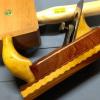I'm sure there are as many ways as there are people, projects or materials. But while sawing and gluing my upper kitchen cabinets last night, I was wondering if there was a more efficient way that would still be strong enough.
Using 3/4" prefinished maple ply for the tops and sides and 1/2" for the back I made dadoes in the sides for the top, bottom, and back, and a dadoe in the top for the back. I glued it all together and then used screws instead of clamps (which I have done in the past w/o screws) so that I could do more than 1 at a time (limited number of longer clamps). Plus, clamping is so clumsy.
Is there a better way for prefinished stuff?
Looking forward to your responses




 Reply With Quote
Reply With Quote














